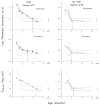Development of scotopic visual thresholds in retinopathy of prematurity
- PMID: 17898313
- PMCID: PMC2225992
- DOI: 10.1167/iovs.07-0406
Development of scotopic visual thresholds in retinopathy of prematurity
Abstract
Purpose: To test the hypothesis that the late-maturing parafoveal rod photoreceptors are more vulnerable than peripheral rods to the effects of retinopathy of prematurity (ROP).
Methods: Twenty-four infants with a history of preterm birth (gestational age at birth </=31 weeks) participated in a longitudinal study: 12 had mild ROP that resolved without treatment, and 12 had never had ROP. Thresholds for detecting stimuli (2 degrees diameter, 50 ms duration) presented 10 degrees (parafoveal) and 30 degrees (peripheral) from a central fixation target were estimated by using a preferential-looking
Method: At each visit, thresholds at both sites were obtained in random order. Thresholds of the preterm subjects were compared with those of previously reported term infants.
Results: The course of threshold maturation in subjects with ROP was significantly prolonged (P </= 0.01) compared with those who had never had ROP and with term-born control subjects. On average, parafoveal thresholds in subjects with ROP reached the adult level at a median age of 12 (range, 6-18) months, and peripheral thresholds reached the adult level at 9 (range, 5-12) months. Median thresholds in subjects who had never had ROP reached adult levels at both sites by approximately 7 months.
Conclusions: The slower development of parafoveal compared with peripheral thresholds in subjects with a history of ROP is evidence that the late-maturing parafoveal rods are more affected by the ROP disease process.
Figures





References
-
- LaVail MM, Rappaport DH, Rakic P. Cytogenesis in the monkey retina. J Comp Neurol. 1991;309:86–114. - PubMed
-
- Hendrickson AE, Drucker D. The development of parafoveal and midperipheral retina. Behav Brain Res. 1992;19:21–32. - PubMed
-
- Hendrickson AE. The morphologic development of human and monkey retina. In: Albert DM, Jakobiec FA, editors. Principles and Practice of Ophthalmology: Basic Sciences. Philadelphia: WB Saunders Co.; 1994. pp. 561–577.
-
- Dorn EM, Hendrickson L, Hendrickson AE. The appearance of rod opsin during monkey retinal development. Invest Ophthalmol Vis Sci. 1995;36:2634–2651. - PubMed
-
- Timmers AM, Fox D, He L, Hansen RM, Fulton AB. Rod photoreceptor maturation does not vary with retinal eccentricity in mammalian retina. Curr Eye Res. 1999;18:393–402. - PubMed
Publication types
MeSH terms
Grants and funding
LinkOut - more resources
Full Text Sources
Other Literature Sources

